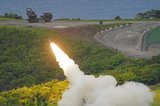QinetiQ's Zephyr solar-powered unmanned aerial system is flown by US Naval Air Warfare Center personnel
QinetiQ's Zephyr High-Altitude Long-Endurance unmanned aerial system (HALE UAS) programme recently resumed flight testing and payload evaluations in Yuma, Arizona, when a joint US/UK Zephyr team undertook the first operation of the system with a US flight crew.
This test sequence, jointly sponsored by MOD UK and OSD DDRE JCTD programme, focused on evaluating potential payloads as well as advancing the conops for operating long endurance persistent aircraft in excess of five days.
The Zephyr concept is designed to offer solar-powered, persistent coverage with continuous mission durations of up to three months at a revolutionary low-cost per flight hour. Capable of carrying a variety of payloads, the applications of the system include wide area surveillance, communications relay, specific target monitoring, anti-piracy efforts, route monitoring, counter-IED, border security, and local area security.
An ultra-lightweight carbon-fibre aircraft, Zephyr weighing less than 100 pounds with a wingspan of up to 75 feet. Launched by hand, Zephyr is solar powered during the day using United Solar Ovonic amorphous silicon arrays no thicker than sheets of paper that cover the aircraft's wings. At night it is powered by lithium-sulphur batteries supplied by the SION Power Corporation that are recharged during the day using solar power.
The US Army's Yuma proving ground in Arizona was the site of Zephyr's world-beating three and a half day flight in July’08 – the fourth of a series of flight trials that have been flown in the US since 2005.
This was the first deliverable following a new enabling contract awarded earlier this year to QinetiQ North America that runs until May 2014 and gives access to up to $44.8 million for operational training in the US, accelerated development, in-theatre evaluation and possible transition to production of Zephyr and its associated ground station.
The $44.8m cost-plus-fixed-fee enabling contract was competitively procured via a Broad Agency Announcement led by the Naval Air Warfare Center Aircraft Division, Lakehurst, NJ. The contract award marks the second phase of a Joint Capability Technology Demonstration (JCTD) programme jointly sponsored by the OSD DDRE and the United Kingdom MOD.
More from Uncrewed Vehicles
-
![What's next for the Pentagon after the Replicator programme?]()
What's next for the Pentagon after the Replicator programme?
Although the Replicator initiative has made several accomplishments, there are still multiple gaps to plug across the US Department of Defense (DoD) and its services.
-
![Cummings Aerospace showcases Hellhound loitering munition designed for US Army’s LASSO programme (video)]()
Cummings Aerospace showcases Hellhound loitering munition designed for US Army’s LASSO programme (video)
Cummings Aerospace presented its turbojet-powered Hellhound loitering munition at SOF Week 2025, offering a man-portable solution aligned with the US Army’s LASSO requirements.
-
![SOF Week 2025: PDW unveils attritable FPV drone for SOF operations at scale]()
SOF Week 2025: PDW unveils attritable FPV drone for SOF operations at scale
PDW has revealed its Attritable Multirotor First Person View drone at SOF Week 2025, offering special operations forces a low-cost, rapidly deployable platform for strike and ISR missions, inspired by battlefield lessons from Ukraine.
-
![SOF Week 2025: Teledyne FLIR white paper provides guidance on reusable loitering munitions]()
SOF Week 2025: Teledyne FLIR white paper provides guidance on reusable loitering munitions
Teledyne FLIR is highlighting the emerging requirements for 'recoverable and re-usable' loitering munitions across the contemporary operating environment during this week’s SOF Week conference in Tampa, Florida.
-
![SOF Week 2025: Kraken Technology group debuts K3 Scout USV in North America]()
SOF Week 2025: Kraken Technology group debuts K3 Scout USV in North America
High-performance maritime industry player Kraken Technology Group, based in the UK, has used the SOF Week conference in Tampa, Florida this week to debut its K3 Scout uncrewed surface vessel (USV) to the North American market.
-
![Palladyne AI and Red Cat to demonstrate capabilities for autonomous drone swarms to the US military]()
Palladyne AI and Red Cat to demonstrate capabilities for autonomous drone swarms to the US military
Red Cat and Palladyne AI recently conducted a cross-platform collaborative flight involving three diverse heterogeneous drones.

























